steering wheel MAZDA MODEL MX-5 MIATA RF 2020 Owners Manual
[x] Cancel search | Manufacturer: MAZDA, Model Year: 2020, Model line: MODEL MX-5 MIATA RF, Model: MAZDA MODEL MX-5 MIATA RF 2020Pages: 566, PDF Size: 62.47 MB
Page 19 of 566
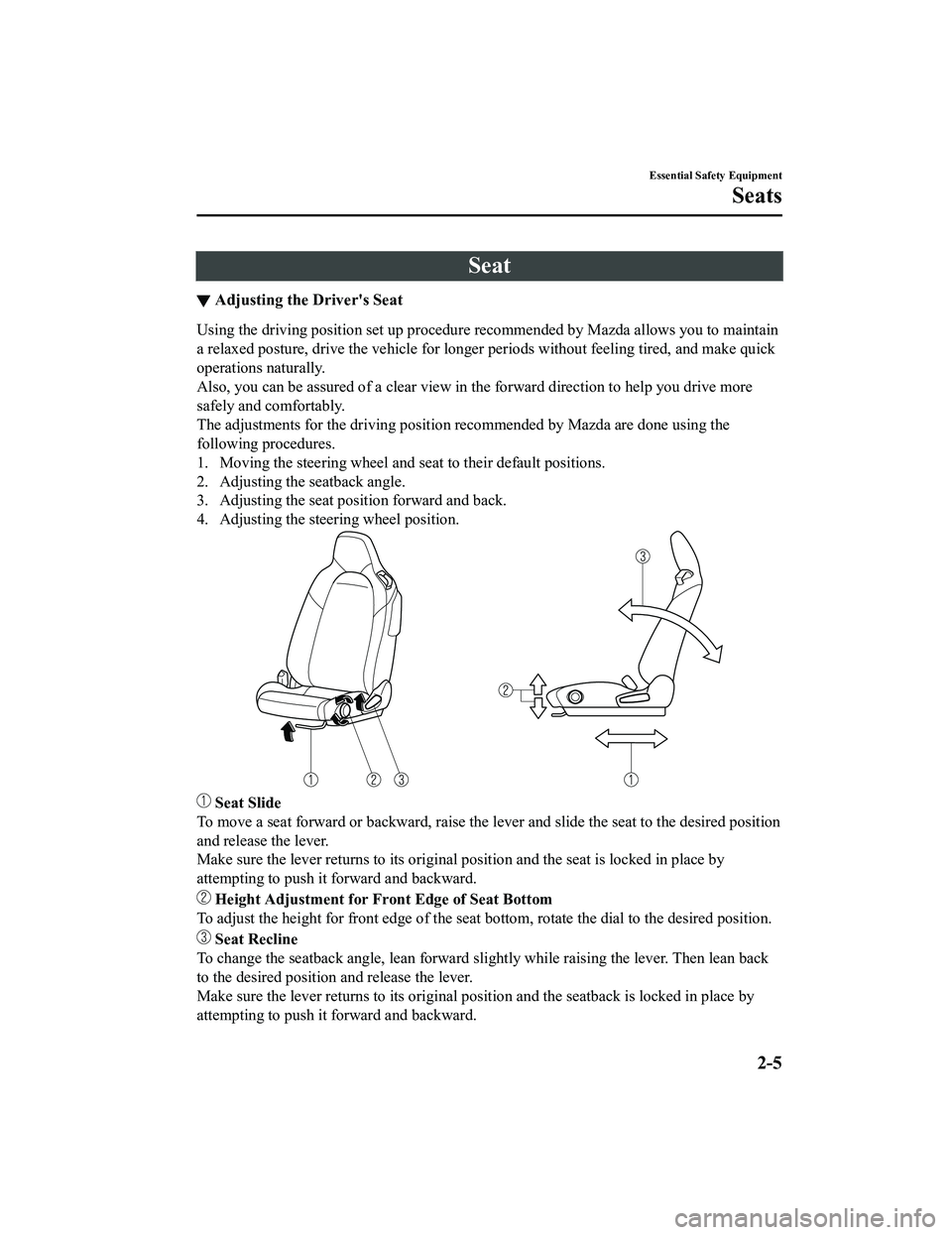
Seat
▼Adjusting the Driver's Seat
Using the driving position set up procedure recommended by Mazd
a allows you to maintain
a relaxed posture, drive the vehicle for longer periods without feeling tired, and make quick
operations naturally.
Also, you can be assured of a clear view in the forward directi on to help you drive more
safely and comfortably.
The adjustments for the driving position recommended by Mazda a re done using the
following procedures.
1. Moving the steering wheel and seat to their default positions .
2. Adjusting the seatback angle.
3. Adjusting the seat position forward and back.
4. Adjusting the steering wheel position.
Seat Slide
To move a seat forward or backward, raise the lever and slide t he seat to the desired position
and release the lever.
Make sure the lever returns to i ts original position and the seat is locked in place by
attempting to push it forward and backward.
Height Adjustment for Front Edge of Seat Bottom
To adjust the height for front e dge of the seat bottom, rotate the dial to the desired position.
Seat Recline
To change the seatback angle, lean forward slightly while raisi ng the lever. Then lean back
to the desired position and release the lever.
Make sure the lever returns to i ts original position and the seatback is locked in place by
attempting to push it forward and backward.
Essential Safety Equipment
Seats
2-5
MX-5_8JA4-EA-19K_Edition1_old 2019-8-29 16:18:06
Page 20 of 566
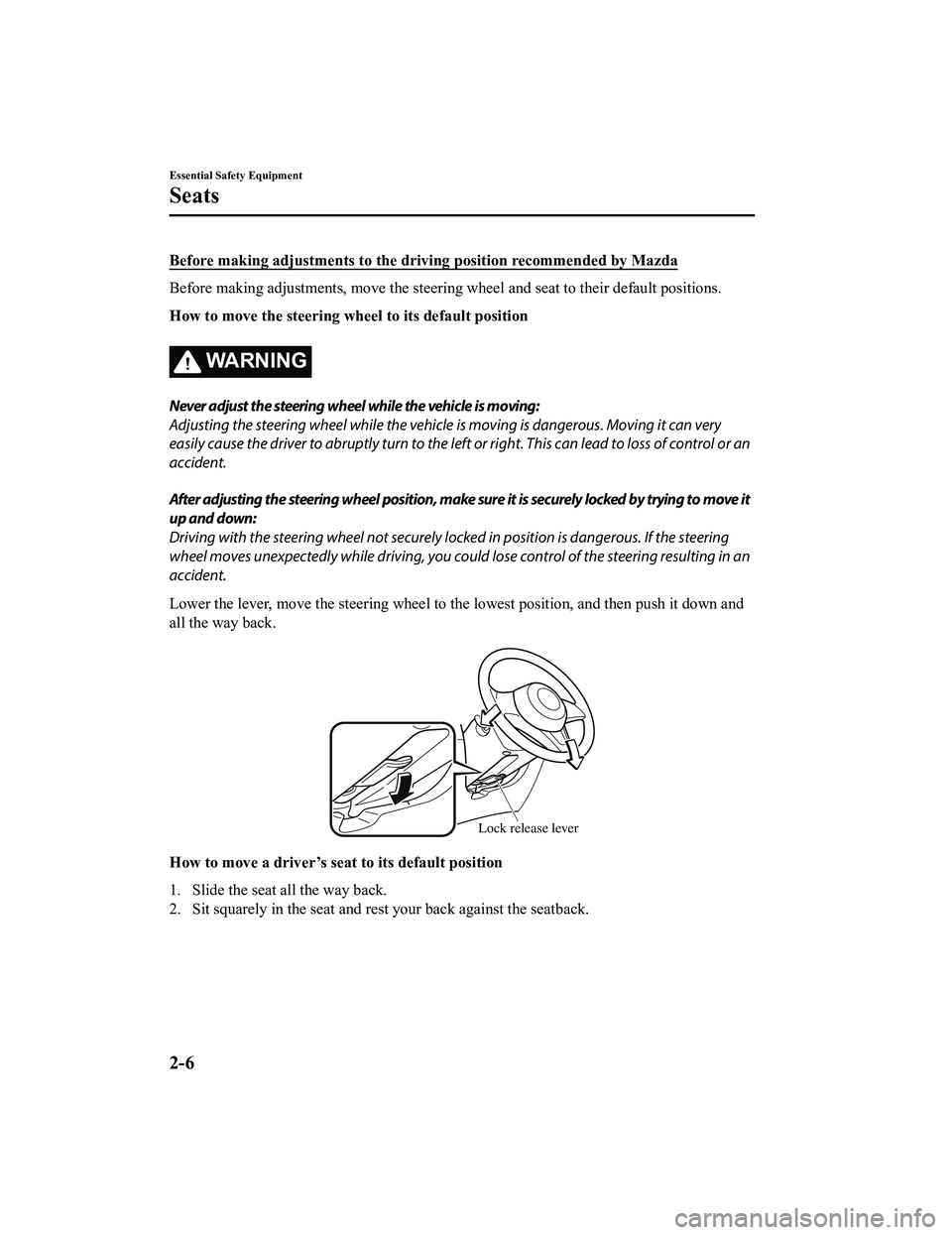
Before making adjustments to the driving position recommended by Mazda
Before making adjustments, move the steering wheel and seat to their default positions.
How to move the steering wheel to its default position
WA R N I N G
Never adjust the steering wheel while the vehicle is moving:
Adjusting the steering wheel while the vehicle is moving is dangerous. Moving it can very
easily cause the driver to abruptly turn to the left or right. This can lead to loss of control or an
accident.
After adjusting the steering wheel position, make sure it is securely locked by trying to move it
up and down:
Driving with the steering wheel not securely locked in position is dangerous. If the steering
wheel moves unexpectedly while driving, you coul d lose control of the steering resulting in an
accident.
Lower the lever, move the steerin g wheel to the lowest position, and then push it down and
all the way back.
Lock release lever
How to move a driver’s seat to its default position
1. Slide the seat all the way back.
2. Sit squarely in the seat and rest your back against the seatb ack.
Essential Safety Equipment
Seats
2-6
MX-5_8JA4-EA-19K_Edition1_old 2019-8-29 16:18:06
Page 23 of 566
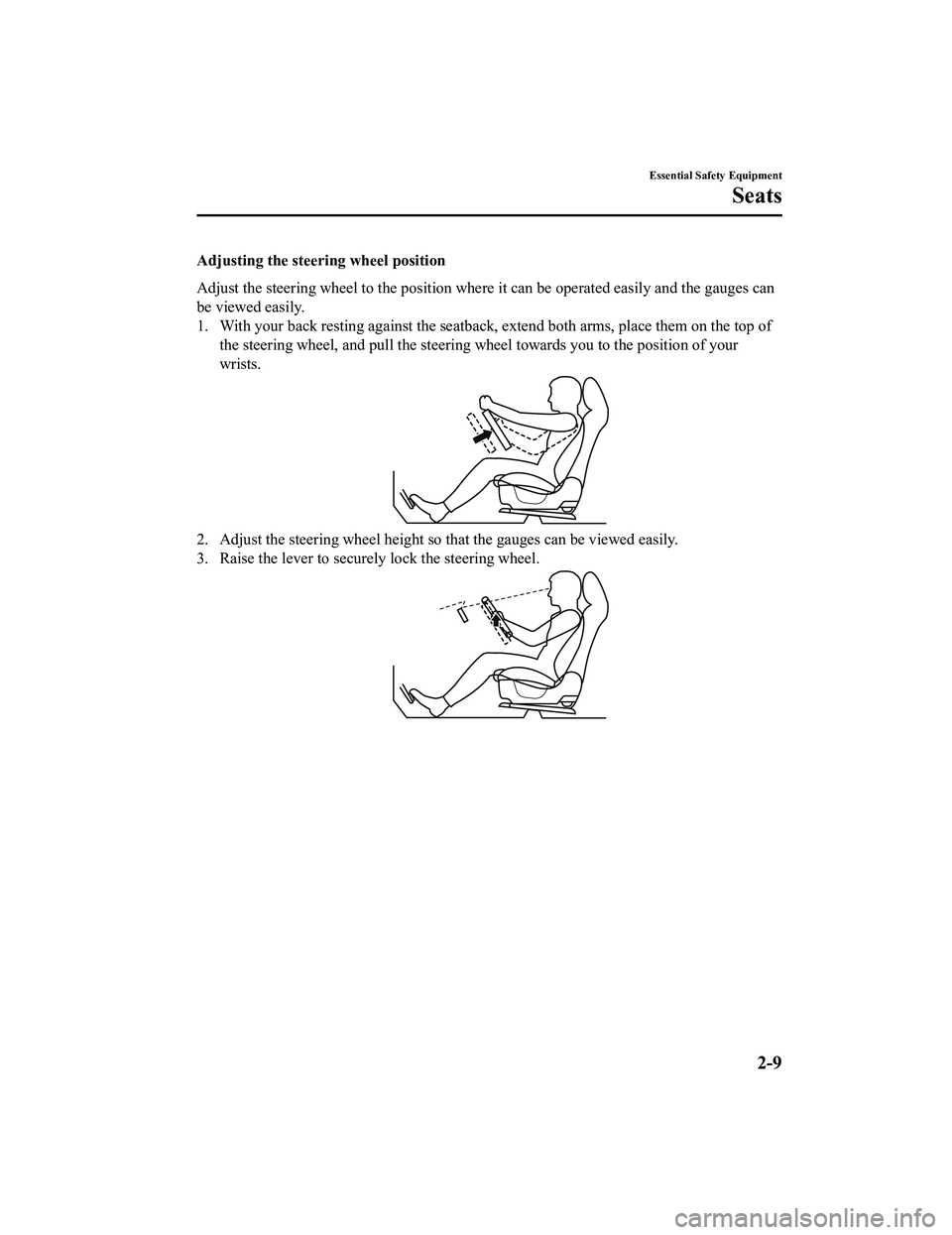
Adjusting the steering wheel position
Adjust the steering wheel to the position where it can be opera ted easily and the gauges can
be viewed easily.
1. With your back resting against the seatback, extend both arms , place them on the top of
the steering wheel, and pull the steering wheel towards you to the position of your
wrists.
2. Adjust the steering wheel height so that the gauges can be vi ewed easily.
3. Raise the lever to securely lock the steering wheel.
Essential Safety Equipment
Seats
2-9
MX-5_8JA4-EA-19K_Edition1_old 2019-8-29 16:18:06
Page 50 of 566
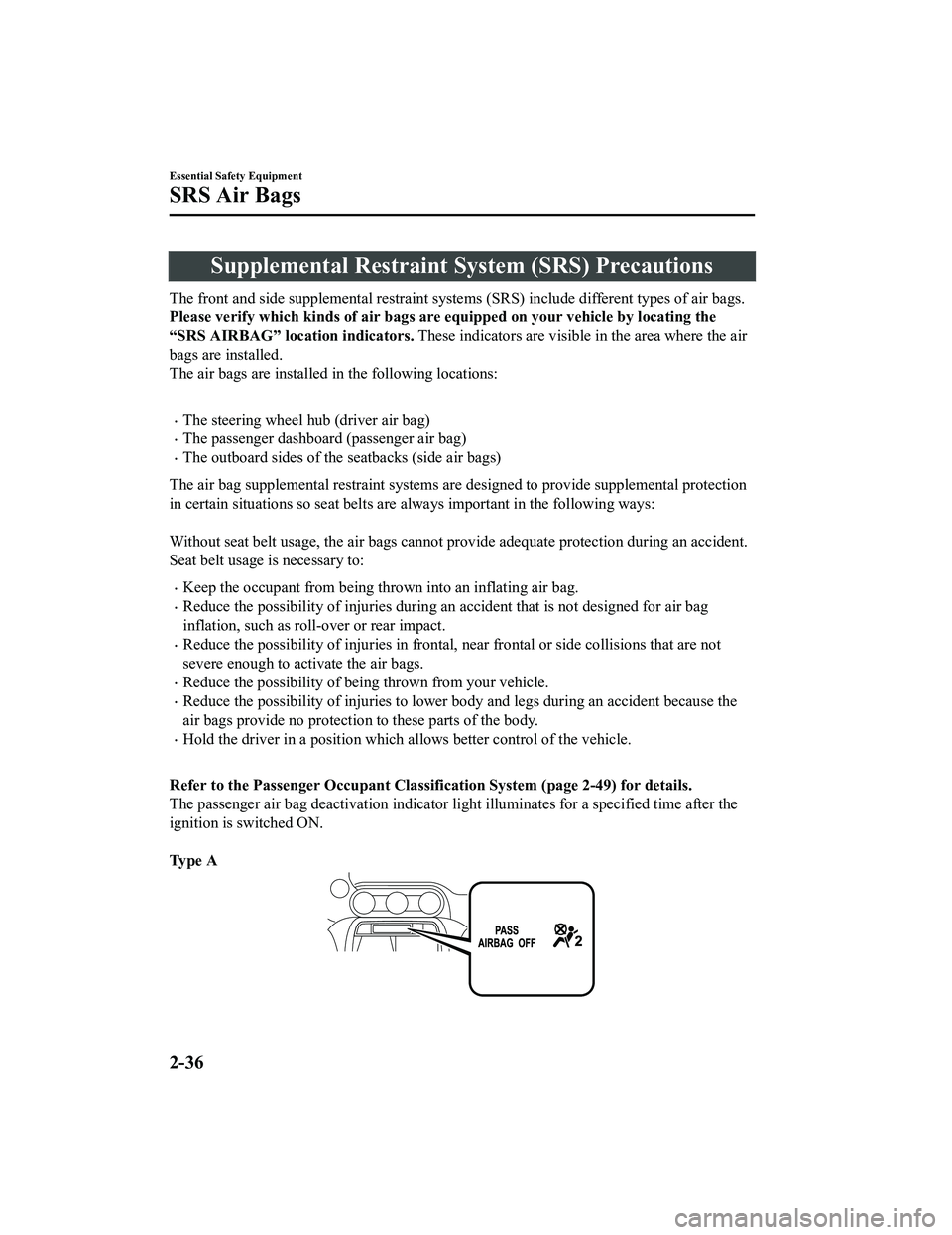
Supplemental Restraint System (SRS) Precautions
The front and side supplemental restraint systems (SRS) include different types of air bags.
Please verify which kinds of air bags are equipped on your vehi cle by locating the
“SRS AIRBAG” loca tion indicators. These indicators are visible in the area where the air
bags are installed.
The air bags are installed in the following locations:
The steering wheel h ub (driver air bag)
The passenger dashboard (passenger air bag)
The outboard sides of the seatbacks (side air bags)
The air bag supplemental restraint systems are designed to prov ide supplemental protection
in certain situations so seat bel ts are always important in the following ways:
Without seat belt usage, the air bags cannot provide adequate p rotection during an accident.
Seat belt usage is necessary to:
Keep the occupant from being thrown into an inflating air bag.
Reduce the possibility of injuries during an accident that is n ot designed for air bag
inflation, such as roll-over or rear impact.
Reduce the possibility of injuries in frontal, near frontal or side collisions that are not
severe enough to activate the air bags.
Reduce the possibility of being thrown from your vehicle.
Reduce the possibility of injurie s to lower body and legs during an accident because the
air bags provide no protection to these parts of the body.
Hold the driver in a position wh ich allows better control of the vehicle.
Refer to the Passenger Occupant Classification System (page 2-49) for details.
The passenger air bag deactivation indicator light illuminates for a specified time after the
ignition is switched ON.
Ty p e A
Essential Safety Equipment
SRS Air Bags
2-36
MX-5_8JA4-EA-19K_Edition1_old 2019-8-29 16:18:06
Page 52 of 566
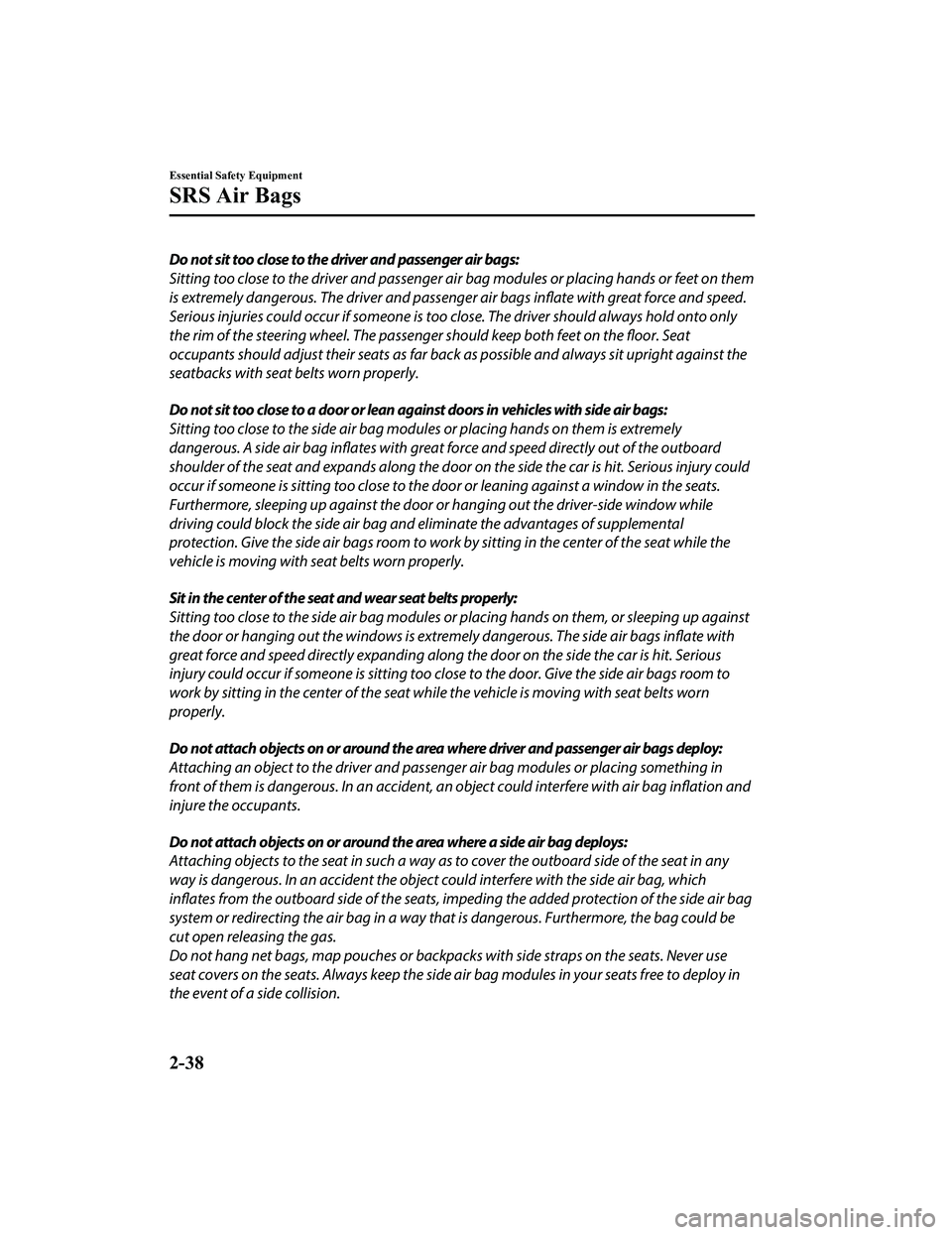
Do not sit too close to the driver and passenger air bags:
Sitting too close to the driver and passenger air bag modules or placing hands or feet on them
is extremely dangerous. The driver and passeng er air bags inflate with great force and speed.
Serious injuries could occur if someone is too close. The driver should always hold onto only
the rim of the steering wheel. The passenger should keep both feet on the floor. Seat
occupants should adjust their seats as far back as possible and always sit upright against the
seatbacks with seat belts worn properly.
Do not sit too close to a door or lean against doors in vehicles with side air bags:
Sitting too close to the side air bag module s or placing hands on them is extremely
dangerous. A side air bag inflates with great force and speed directly out of the outboard
shoulder of the seat and expands along the door on the side the car is hit. Serious injury could
occur if someone is sitting too close to the d oor or leaning against a window in the seats.
Furthermore, sleeping up against the door or hanging out the driver-side window while
driving could block the side air bag and eliminate the advantages of supplemental
protection. Give the side air bags room to work by sitting in the center of the seat while the
vehicle is moving with seat belts worn properly.
Sit in the center of the seat and wear seat belts properly:
Sitting too close to the side air bag modules or placing hands on them, or sleeping up against
the door or hanging out the windows is extremely dangerous. The side air bags
inflate with
great force and speed directly expanding along th e door on the side the car is hit. Serious
injury could occur if someone is sitting too clos e to the door. Give the side air bags room to
work by sitting in the center of the seat while the vehicle is moving with seat belts worn
properly.
Do not attach objects on or around the area where driver and passenger air bags deploy:
Attaching an object to the driver and passenger air bag modules or placing something in
front of them is dangerous. In an accident, an object could interfere with air bag inflation and
injure the occupants.
Do not attach objects on or around the area where a side air bag deploys:
Attaching objects to the seat in such a way as to cover the outboard side of the seat in any
way is dangerous. In an accident the object could interfere with the side air bag, which
inflates from the outboard side of the seats, impe ding the added protection of the side air bag
system or redirecting the air bag in a way that is dangerous. Furthermore, the bag could be
cut open releasing the gas.
Do not hang net bags, map pouches or backpacks with side straps on the seats. Never use
seat covers on the seats. Always keep the side air bag modules in your seats free to deploy in
the event of a side collision.
Essential Safety Equipment
SRS Air Bags
2-38
MX-5_8JA4-EA-19K_Edition1_old 2019-8-29 16:18:06
Page 54 of 566
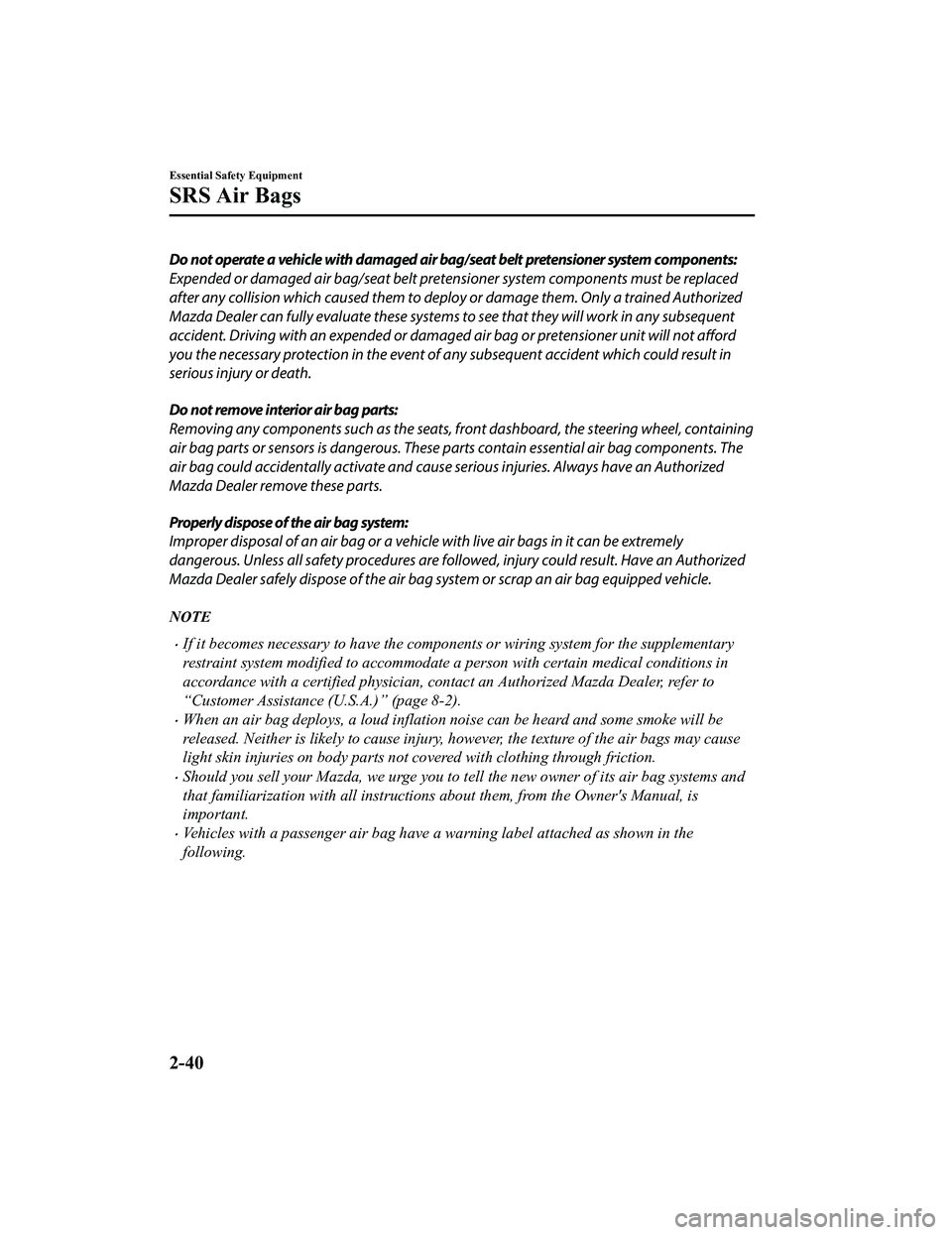
Do not operate a vehicle with damaged air bag/seat belt pretensioner system components:
Expended or damaged air bag/seat belt pretensioner system components must be replaced
after any collision which caused them to depl oy or damage them. Only a trained Authorized
Mazda Dealer can fully evaluate these systems to see that they will work in any subsequent
accident. Driving with an expended or damage d air bag or pretensioner unit will not afford
you the necessary protection in the event of any subsequent accident which could result in
serious injury or death.
Do not remove interior air bag parts:
Removing any components such as the seats, front dashboard, the steering wheel, containing
air bag parts or sensors is dangerous. These pa rts contain essential air bag components. The
air bag could accidentally activate and cause serious injuries. Always have an Authorized
Mazda Dealer remove these parts.
Properly dispose of the air bag system:
Improper disposal of an air bag or a vehicle with live air bags in it can be extremely
dangerous. Unless all safety procedures are foll owed, injury could result. Have an Authorized
Mazda Dealer safely dispose of the air bag sy stem or scrap an air bag equipped vehicle.
NOTE
If it becomes necessary to have the components or wiring system for the supplementary
restraint system modified to accommodate a person with certain medical conditions in
accordance with a certified physician, contact an Authorized Mazda Dealer, refer to
“Customer Assistance (U.S.A.)” (page 8-2).
When an air bag deploys, a loud inflation noise can be heard and some smoke will be
released. Neither is likely to cause injury, however, the text ure of the air bags may cause
light skin injuries on body parts not covered with clothing through friction.
Should you sell your Mazda, we urge you to tell the new owner of its air bag systems and
that familiarization with all instructions about them, from the Owner's Manual, is
important.
Vehicles with a passenger air bag have a warning label attached as shown in the
following.
Essential Safety Equipment
SRS Air Bags
2-40
MX-5_8JA4-EA-19K_Edition1_old 2019-8-29 16:18:06
Page 57 of 566
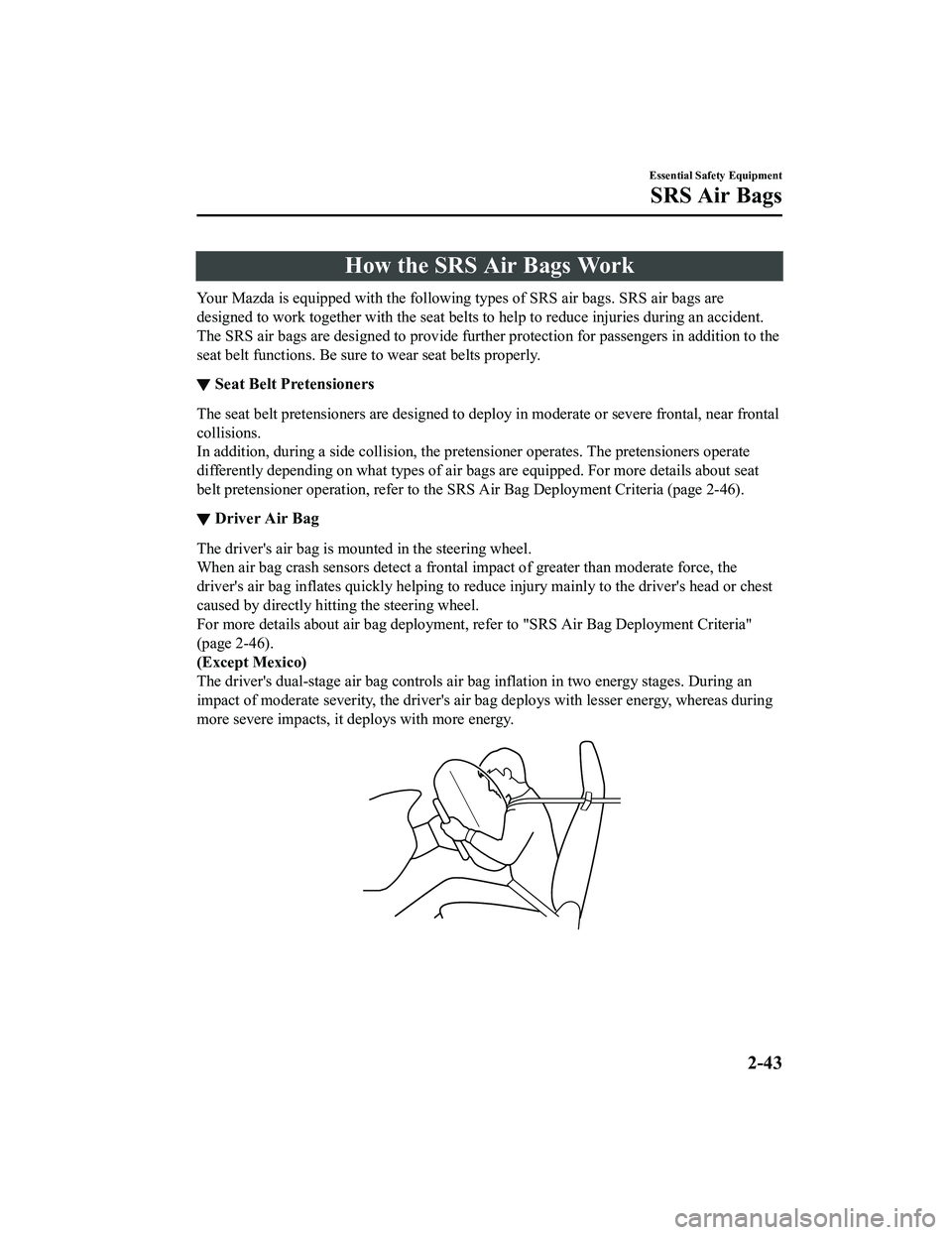
How the SRS Air Bags Work
Your Mazda is equipped with the following types of SRS air bags. SRS air bags are
designed to work together with the seat belts to help to reduce injuries during an accident.
The SRS air bags are designed to provide further protection for passengers in addition to the
seat belt functions. Be sure to wear seat belts properly.
▼ Seat Belt Pretensioners
The seat belt pretensioners are designed to deploy in moderate
or severe frontal, near frontal
collisions.
In addition, during a side collision, the pretensioner operates . The pretensioners operate
differently depending on what types of air bags are equipped. F or more details about seat
belt pretensioner operation, refer to the SRS Air Bag Deployment Criteria (page 2-46).
▼ Driver Air Bag
The driver's air bag is mounted in the steering wheel.
When air bag crash sensors detect a frontal impact of greater than moderate force, the
driver's air bag inflates quickly
helping to reduce injury mainly to the driver's head or chest
caused by directly hitting the steering wheel.
For more details about air bag deployment, refer to "SRS Air Ba g Deployment Criteria"
(page 2-46).
(Except Mexico)
The driver's dual-stage air bag controls air bag inflation in two energy stages. During an
impact of moderate severity, the driver's air bag deploys with lesser energy, whereas during
more severe impacts, it deploys with more energy.
Essential Safety Equipment
SRS Air Bags
2-43
MX-5_8JA4-EA-19K_Edition1_old 2019-8-29 16:18:06
Page 121 of 566
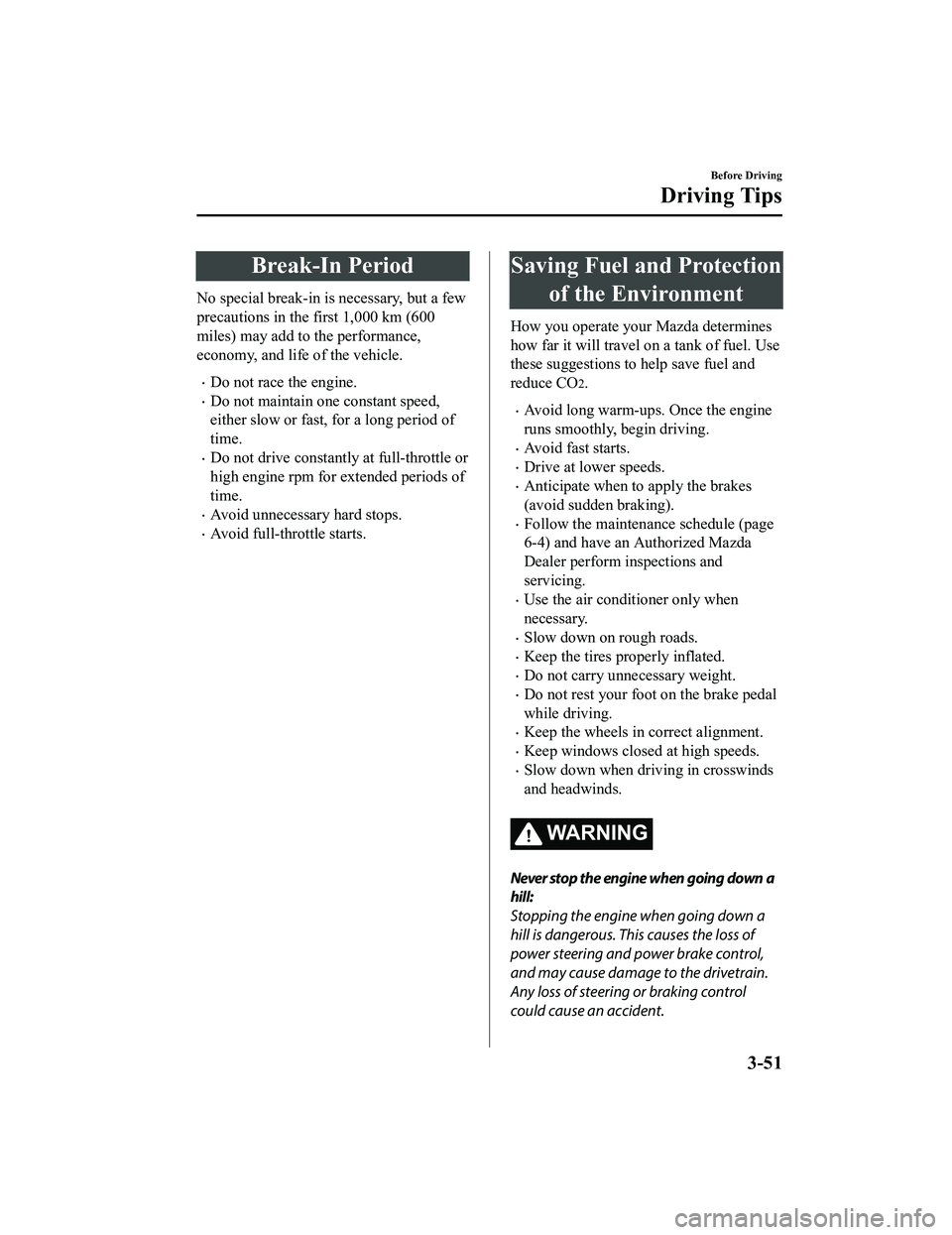
Break-In Period
No special break-in is necessary, but a few
precautions in the first 1,000 km (600
miles) may add to the performance,
economy, and life of the vehicle.
Do not race the engine.
Do not maintain one constant speed,
either slow or fast, for a long period of
time.
Do not drive constantly at full-throttle or
high engine rpm for extended periods of
time.
Avoid unnecessary hard stops.
Avoid full-throttle starts.
Saving Fuel and Protection of the Environment
How you operate your Mazda determines
how far it will travel on a tank of fuel. Use
these suggestions to help save fuel and
reduce CO
2.
Avoid long warm-ups. Once the engine
runs smoothly, begin driving.
Avoid fast starts.
Drive at lower speeds.
Anticipate when to apply the brakes
(avoid sudden braking).
Follow the maintenance schedule (page
6-4) and have an Authorized Mazda
Dealer perform inspections and
servicing.
Use the air conditioner only when
necessary.
Slow down on rough roads.
Keep the tires properly inflated.
Do not carry unnecessary weight.
Do not rest your foot on the brake pedal
while driving.
Keep the wheels in correct alignment.
Keep windows closed at high speeds.
Slow down when driving in crosswinds
and headwinds.
WA R N I N G
Never stop the engine when going down a
hill:
Stopping the engine when going down a
hill is dangerous. This causes the loss of
power steering and power brake control,
and may cause damage to the drivetrain.
Any loss of steering or braking control
could cause an accident.
Before Driving
Driving Tips
3-51
MX-5_8JA4-EA-19K_Edition1_old 2019-8-29 16:18:06
Page 166 of 566

Manual Shift Mode
The manual shift mode gives you the feel
of driving a manual transmission vehicle
by allowing you to operate the selector
lever manually. This allows you to control
engine rpm and torque to the drive wheels
much like a manual transmission when
more control is desired.
To change to manual shift mode, shift the
lever from D to M.
NOTE
Changing to manual shift mode while
driving will not damage the transmission.
To return to automatic shift mode, shift the
lever from M to D.
NOTE
If you change to manual shift mode
when the vehicle is stopped, the gear
will shift to M1.
If you change to manual shift mode
without depressing the accelerator pedal
when driving in D range, 5th gear/6th
gear, the gear will shift to M4/M5.
▼Indicators
Manual shift mode indication
In manual shift mode, the “M” of the shift
position indication in
the instrument panel
illuminates.
Gear position indication
The numeral for th e selected gear
illuminates.
Manual shift mode indication
Gear position indication
NOTE
If the gears cannot be shifted down
when driving at higher speeds, the gear
position indication will flash twice to
signal that the gears cannot be shifted
down (to protect the transmission).
▼ Manually Shifting Up
You can shift gears up by operating the
selector lever or the steering shift
switches
*.
M1 → M2 → M3 → M4 → M5 → M6
Using selector lever
To shift up to a h igher gear, tap the
selector lever back
once.
When Driving
Automatic Transmission
4-38*Some models.
MX-5_8JA4-EA-19K_Edition1_old 2019-8-29 16:18:06
Page 167 of 566
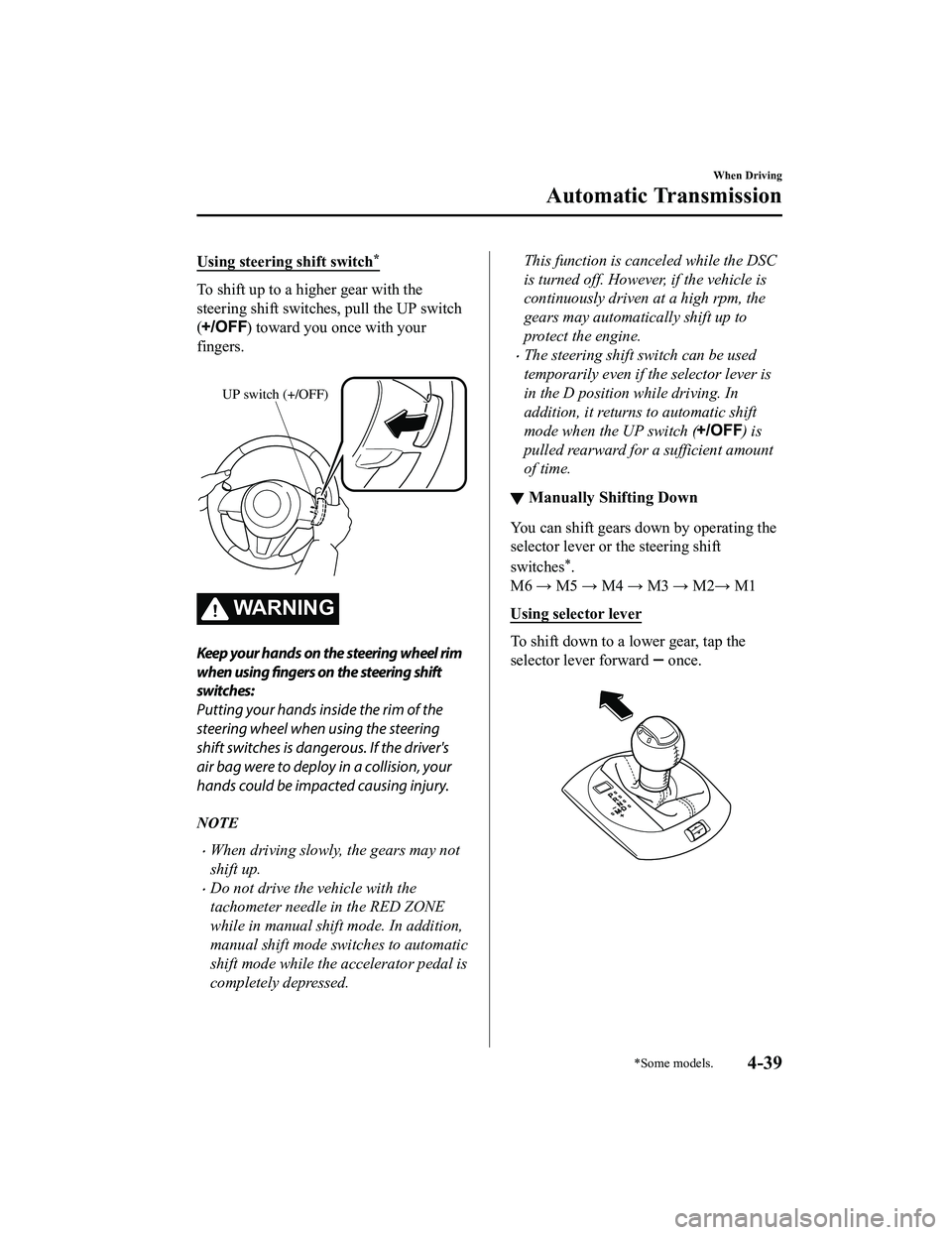
Using steering shift switch*
To shift up to a higher gear with the
steering shift switches, pull the UP switch
(
) toward you once with your
fingers.
UP switch (+/OFF)
WA R N I N G
Keep your hands on the steering wheel rim
when using fingers on the steering shift
switches:
Putting your hands inside the rim of the
steering wheel when using the steering
shift switches is dangerous. If the driver's
air bag were to deploy in a collision, your
hands could be impacted causing injury.
NOTE
When driving slowly, the gears may not
shift up.
Do not drive the vehicle with the
tachometer needle in the RED ZONE
while in manual shift mode. In addition,
manual shift mode switches to automatic
shift mode while the accelerator pedal is
completely depressed.
This function is canceled while the DSC
is turned off. However, if the vehicle is
continuously driven at a high rpm, the
gears may automatically shift up to
protect the engine.
The steering shift switch can be used
temporarily even if the selector lever is
in the D position while driving. In
addition, it returns to automatic shift
mode when the UP switch (
) is
pulled rearward for a sufficient amount
of time.
▼ Manually Shifting Down
You can shift gears down by operating the
selector lever or
the steering shift
switches
*.
M6 → M5 → M4 → M3 → M2→ M1
Using selector lever
To shift down to a lower gear, tap the
selector lever forward
once.
When Driving
Automatic Transmission
*Some models.4-39
MX-5_8JA4-EA-19K_Edition1_old 2019-8-29 16:18:06